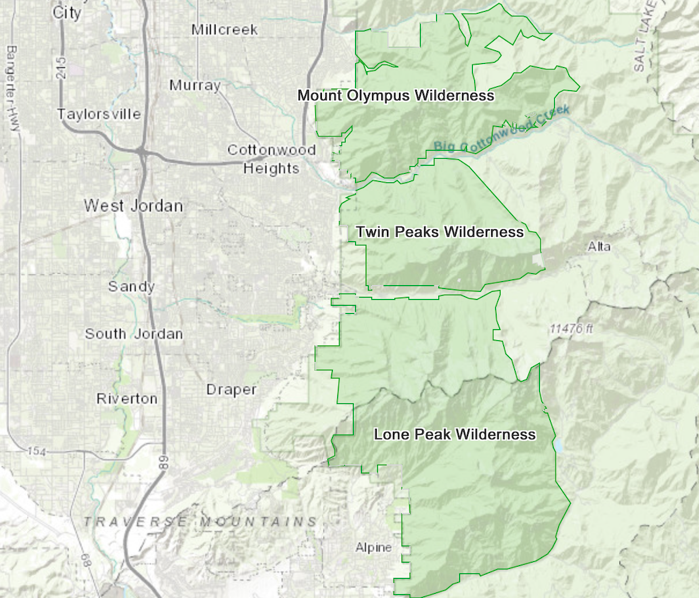Lone Peak Wilderness
What is Lone Peak?

Lone Peak Wilderness consists of 30,735 acre in the Central Wasatch Mountains, located southeast of Salt Lake City. This wilderness area was designated in 1978 by the Endangered American Wilderness Act. This was the only established wilderness in Utah until the Utah Wilderness Act was passed in 1984.
Lone Peak Wilderness Area goes as far north as Little Cottonwood Canyon and south to American Fork Canyon. Its elevation ranges from 5,500 to 11,326 feet. The two highest and notable peaks in this area are Lone Peak at 11,253 feet and Little Matterhorn at 11,326 feet.
For more information about Wilderness areas:
https://www.nps.gov/subjects/wilderness/index.htm
https://www.blm.gov/programs/national-conservation-lands/wilderness
https://www.fs.fed.us/managing-land/wilderness
Geology:
Lone Peak Wilderness allows recreationists to escape the hustle and bustle of the Salt Lake Valley by only traveling minutes to this area. It is known for its high rigid peaks that reach over 11,000 feet, as well as narrow valleys, open basins, and rigorous terrain. Its geological features consist of sedimentary formations, masses of granitoid rock, and glacial topography. Currently, erosion is the strongest force sculpting the land in this area. Small lakes and streams are found in a few areas throughout Lone Peak Wilderness.
Commonly asked questions:
Where are wilderness areas?
There are three designated wilderness areas in the Central Wasatch Mountains. These areas are Twin Peaks, Mt Olympus and Lone Peaks Wilderness Areas. They are located east and southeast of Salt Lake City.
Why are wilderness areas important?
There are many reasons why designated wilderness areas are important and should be protected. First, some designated wilderness areas are watersheds and provide clean drinking water that goes to thousands of people. Second, they provide places for visitors to discover peace, solitude and opportunities for outdoor recreation. Third, designated wilderness areas provide economic opportunities by providing jobs and attracting tourism. Fourth, these areas provide undisturbed ecosystems for wildlife, helping to preserve species.
Can you swim in wilderness areas?
Swimming is permitted in wilderness areas that are also not designated watersheds. The majority of the Central Wasatch is a watershed area, which limits where users can swim. Part of Lone Peak Wilderness is inside the Watershed boundary. This puts restrictions on swimming, camping and bringing in domesticated animals. The northern and central part of Lone Peak is a watershed area.
Are fires permitted in wilderness areas?
Fires are permitted in wilderness areas, but some areas have restrictions. In the Lone Peak Wilderness Area, campfires are not permitted in Silver Lake Basin, Red Pine and Maybird Drainages. Fires are restricted in this area due to it being a popular backcountry camping location. Excessive gathering of dead and downed wood degrades animal and plant habitat and negatively affects soil quality.
Trails:
There are 14 trail systems that run for 46 miles in the Lone Peak Wilderness. Six of these trails are in the Salt Lake City Ranger District, and 8 trails in the Pleasant Grove Ranger District. These trails consist of:
Jacob’s Ladder Trail
Red Pine Lake Trail
White Pine Lake Trail
Maybird Gulch Trail
Bells Canyon Trail
Outlaw Cabin Trail
Deer Creek-Dry Creek Trail
Silver Lake Trail
American Fork Twin Peaks from Silver Lake Flat
Box Elder Trail
White Canyon Trail
Sawmill Trail
Cherry Canyon Logging Trail
To learn more about hiking in this area:
https://www.alltrails.com/explore/parks/us/utah/lone-peak-wilderness
Rules/restrictions:
General Wilderness Rules:
There are specific rules and regulations that users must follow in wilderness areas.
These rules are:
- Motorized equipment is prohibited.
- Equipment used for mechanical transport are prohibited.
- Motor vehicles, motor boats, bikes, carts, gliders, wagons and the landing of aircraft and helicopters are all prohibited.
- Camping in one spot for more than 3 days is prohibited in Lone Peak Wilderness on the Salt Lake Ranger District.
Specific Lone Peak Rules:
There are specific rules and regulations that users must follow when in Lone Peak.
These rules are:
- Maximum group size on the Salt Lake Ranger District is 10 people.
- Maximum group size on the Pleasant Grove Ranger District is 15 people.
- Campfires are prohibited in the Silver Lake Basin, Red Pine and Maybird Drainages.
- Cutting switchbacks is prohibited.
Watershed Rules:
There are specific rules for protected watersheds, which includes part of Lone Peak Wilderness:
- No dogs or domesticated animals.
- Must camp 200 feet or farther from any body of water.
- No swimming, wading, washing clothing, utensils and other products.
- Water pollution is prohibited.
- If no approved toilets are available, you must be at least 200 ft away from water and trails, while also burying excreta 6” underground.
To read more about wilderness rules:
https://www.wilderness.net/NWPS/wildView?WID=330&tab=Area%20Management
Seven Leave No Trace Principles
These are commonly used practices in wilderness areas and watershed areas because they limit impact on an area and help keep the area healthy. Leave No Trace principles are:
- Plan Ahead & Be Prepared
- Know the regulations and special concerns for the area you’ll visit.
- Prepare for extreme weather, hazards, and emergencies.
- Schedule your trip to avoid times of high use.
- Visit in small groups when possible. Consider splitting larger groups into smaller groups.
- Repackage food to minimize waste.
- Use a map and compass to eliminate the use of marking paint, rock cairns or flagging.
- Travel and Camp on Durable Surfaces
- Durable surfaces include established trails, campsites, rock, gravel, dry grasses or snow.
- Protected riparian areas by camping at least 200 feet from lakes and streams.
- Good campsites are found, not made. Altering a site is not necessary.
- In popular areas:
- Concentrate use on existing trails and campsites.
- Walk in single file in the middle of the trail, even when wet or muddy.
- Keep campsites small. Focus activity in areas where vegetation is absent.
- In pristine areas:
- Disperse use to prevent the creation of campsites and trails
- Avoid places where human impact is just beginning to show.
- Dispose of Waste Properly
- Pack it in, pack it out. Inspect your campsite and rest areas for trash or spilled foods. Pack out all trash, leftover food, and litter.
- Deposit solid human waste in catholes dug 6 to 8 inches deep, at least 200 feet from water, camp and trails. Cover and disguise the cathole when finished.
- Pack out toilet paper and hygiene products.
- To wash yourself or your dishes, carry water 200 feet away from streams or lakes and use small amounts of biodegradable soap. Scatter strained dishwater.
- Leave What You Find
- Preserve the past: examine, but do not touch cultural or historic structures and artifacts.
- Leave rocks, plants and other natural objects as you find them.
- Avoid introducing or transporting non-native species.
- Do not build structures, furniture, or dig trenches.
- Minimize Campfire Impacts
- Campfires can cause lasting impacts to the environment. Use a lightweight stove for cooking and enjoy a candle lantern for light.
- Where fires are permitted, use established fire rings, fire pans, or mound fires.
- Keep fires small. Only use sticks from the ground that can be broken by hand.
- Burn all wood and coals to ash, put out campfires completely, then scatter cool ashes.
- Respect Wildlife
- Observe wildlife from a distance. Do not follow or approach them.
- Never feed animals. Feeding wildlife damages their health, alters natural behaviors, and exposes them to predators and other dangers.
- Protect wildlife and your food by storing rations and trash securely.
- Control pets at all times, or leave them at home.
- Avoid wildlife during sensitive times: mating, nesting, raising young, or winter.
- Be Considerate of Other Visitors
- Respect other visitors and protect the quality of their experience.
- Be courteous. Yield to other users on the trail.
- Step to the downhill side of the trail when encountering pack stock.
- Take breaks and camp away from trails and other visitors.
- Let nature's sounds prevail. Avoid loud voices and noises.
To learn more about Leave No Trace:
Vegetation/animals:

